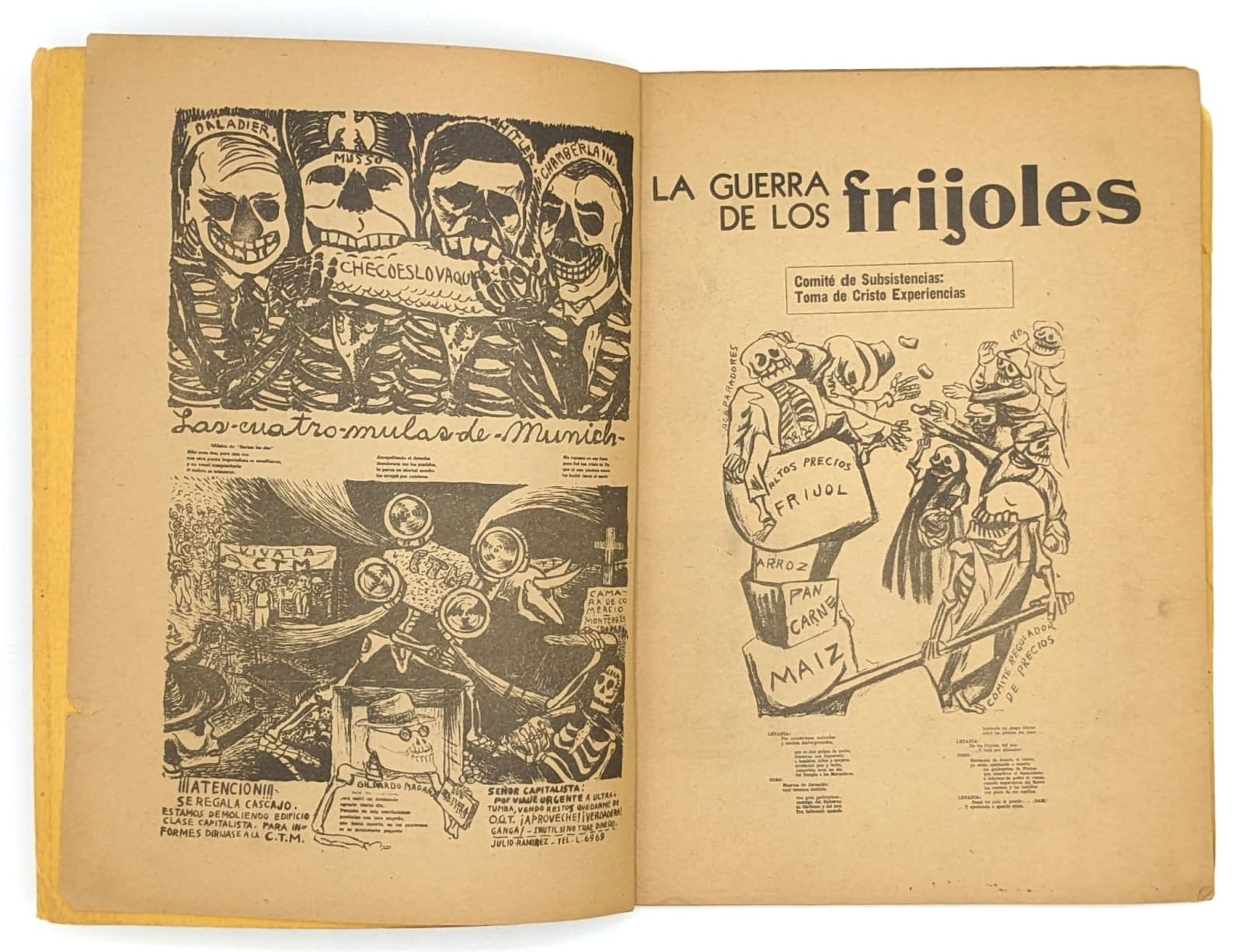




Posada Aguilar, Jose Guadalupe
Only[?] edition, of which we were unable to locate a single copy in OCLC, of this extraordinary collection of Calaveras by Mexican illustrator Guadalupe Posada in form of a comic or satire of sorts, where the calaveras are the illustrations, an exceptional mix of illustration and text, and definitely an unusual type of publication for Posada´s oeuvre.
Further images
4to, (220 x 170 mm). 34 pp., including 5 folding leaves. Original publisher´s yellow illustrated covers. Front cover with small tear on lower corner, a little worn but overall excellent. A little toned as expected for the paper used, but overall in excellent condition.
The publication includes a striking large folding illustration called “Mexico en el arte” picturing an illustrator working at his desk, surrounded by a profuse and eclectic group of calaveras.
Guadalupe Posada Aguilar (1852-1913) is one of the most influential illustrator and artists of Mexico of the 20th century, they represent varied motifs which include politics and political discontent, current events, but overall the social construct of the Mexican society -from the education of children to the education of house wives, to violence and crime, popular games and stories, literature and of course the religiousness of the Mexicans with devotional prints. He was a prolific artist and book illustrator whose work was heavily political in contents and influential for its satirical acuteness and social engagement, both in Mexico and the rest of America. Posada satirized social life of the bourgeois, and political events during the dictatorship of Porfirio Diaz. Amongst his well-known and easily recognizable style, the Calaveras stand out, today closely associated with the Mexican holiday Dia de los Muertos.
The collective works left by Posada are icons of the Mexican 20th century illustration and iconography, his Calaveras are immediately recognizable, both for their originality and their striking appeal. His oeuvre is steeped in social engagement, satirical acuteness, and wry humor presented to the reader and observer in woodcut and lithographic illustrations for periodicals and chapbooks. During the late Porfiriate and early years of the Mexican Revolution, his art enticed the buyers of popular, very cheaply produced songsters; political broadsides; cookbooks; and single-sheet accounts of hangings, disasters, crimes, and other sensational events. All these were mostly published by Antonio Vanegas Arroyo, a publisher who produced mostly inexpensive literature and satirical broadsides, and himself.
“In the decades before the socialist revolution of 1910, millions were enlightened and entertained by José Guadalupe Posada's lurid, eye-catching, marvelous engravings, which were often accompanied by jocular lyrics… Posada, it seems to me, was more than just a populist artist. He invented the most fascinating freaks and grotesque monstrosities, and in that regard he is comparable to Goya, Rudolph von Ripper, Alfred Kubin, Sibylle Ruppert, and the creators of the fabulous beasts and demons of the medieval and Renaissance worlds” (Stavans, Ilan. “José Guadalupe Posada, Lampooner.” The Journal of Decorative and Propaganda Arts 16 (1990): 55–71. https://doi.org/10.2307/1504066).
“The subversive element in Posada´s work is humor -an ingredient that makes his images as compelling today as they were in his time. Through humor, Posada denounced delinquency, assassinations, and corruption. Through humor, he sympathetically described the struggles of popular heroes.” (Stavans).
“Posada, tan grande como Goya o Callot, fue un creador de una riqueza inagotable, producia como un manantial de agua hirviente. Posada, interprete del dolor, la alegría y la aspiración angustiosa del pueblo de Mexico, hizo mas de quince mil grabados, así lo asegura el editor Vanegas Arroyo” (Rivera, Diego, Fernando Gamboa, and Jean Charlot. “JOSE GUADALUPE ‘Posada.’” Artes de México, no. 21 (1958): 3–64. http://www.jstor.org/stable/44747330).
His successful career and the influence his work would have in the 20th century was however, as with many talented artists, no obstacle for him becoming broke, he died poor and was buried in an unmarked grave during the Mexican Revolution that ousted Porfirio Diaz. After his death, his work became one of the most recognizable symbols of Mexican culture, to date.
Extremely rare, we were unable to locate a single copy in OCLC.
Join our mailing list
* denotes required fields
We will process the personal data you have supplied in accordance with our privacy policy (available on request). You can unsubscribe or change your preferences at any time by clicking the link in our emails.





